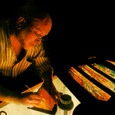contact

Is Art Abstract or Representational?
Rembrandt van Rijn began his career painting very realistic and polished portraits and landscapes. By the end of his career, having satisfied his need to show the world his masterly technique and draftsmanship, he began to paint what was in his heart. His last works are quite literally splashes and daubs of paint. While they still maintain a representational quality, they are abstract in nature. What we carry in our hearts, love for example, is beyond any kind of description that any of our five senses can understand or comprehend. Consider the progression of Michelangelo's "David" created in the beginning of his career to the "Rondanini Pieta" sculpted at the end of his career. The "Rondanini Pieta" is said to be unfinished but the proportions of the figures along with their gestures and harmonious attitudes display a gentle depth of feeling that his earlier works lack. Consider some of the many 20th century examples such as Matisse and Picasso who began painting polished representational images early in their careers but then made a gradually increasing transition into the realm of abstract imagery.
David's Dance
The Lark Ascending
Matisse and Picasso studied human anatomy as did Rembrandt and Michelangelo. All four studied perspective. All four studied traditional drafting and painting techniques. All four utilized abstract compositional themes. Rembrandt ended his career as he excelled in the use of heavy texture; Michelangelo excelled in complimentary color contrasts in the Sistine ceiling and in abstract form in the Rondanini Pieta; Matisse was unsurpassed in the use of patterns; Picasso was a genius of many design elements and principles as were all of the truly great masters.
Personally I can enjoy a polished representational work of art if it combines a solid use of abstract design elements and principles which, when applied together make an aesthetically sound composition. However, an abstract image that is devoid of composition is as dry and lifeless as open space.
A few design principles are balance, harmony, divergence, unity, movement, rhythm, pattern, contrast, proportion and emphasis. Many artists have spent their entire lives concentrating on the combination of only one design element and one design principle.
From the Depths
Scare Crow
Good design depends upon how one orders the basic design elements. There are five design elements; line, shape, color, value, and texture. When working on a flat surface, shape and value work together to create form. On an abstract level, form is the result of the combination and order of one or more of the design elements within the parameters of specific design principles. With the addition of color, the form evokes a stronger "feeling". It is given more substance.
How one orders these design elements within a structured symmetrical or asymmetrical design is dependent upon the personality of the individual artist. Adherence to the development of balance is a traditional, very classical goal. However, for the purpose of evoking certain psychological themes, a strong imbalance can be very effective. You can easily see how an artist could spend an entire lifetime on one design element and one design principle.
Regardless of whether your personal inclination is to paint or draw in a realistic manner or in any one of the many stylized or abstract styles, the simple fact is that all of the great masters recognized the absolute necessity of developing an ever-deepening grasp of both naturalistic form along with abstract design elements and principles.
All images are copyrighted © 2006 to Curtis R Doll Jr - CurtisGraphics Architectural Glass Art & Design Services - All Rights Reserved
Artist - Designer - Painter since 1977 - Curtis R Doll Jr began creating Stained Glass Windows in 1979, cutting glass, assembling the windows including installation and various & sundry jobs that go along with making stained glass - began designing Monumental Architectural Glass Installations in 1983 for churches, storefronts, malls, and continued to design small, residential & commercial projects - in addition, creating computer graphics, manipulating & restoring photographs - creating Digital, Limited Edition Fine Art Prints since 1998.







Post new comment
Please Register or Login to post new comment.